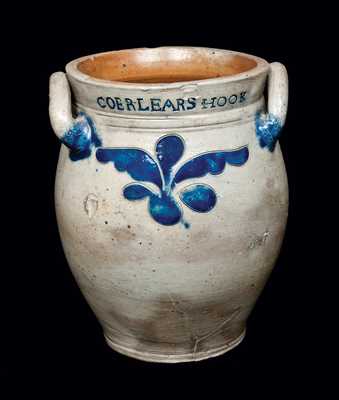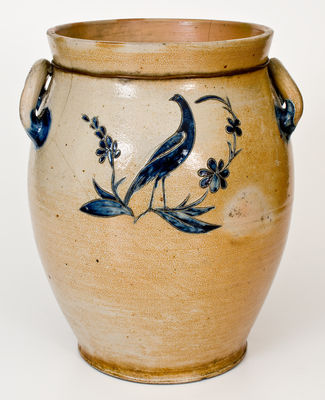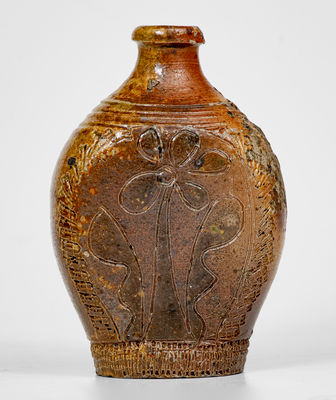Exceptional Diminutive Lidded Stoneware Presentation Jar with Two-Sided Incised Floral Decoration, Inscribed "Rachel Van Riper / November 10th, 1800", Manhattan, New York origin, 1800, quart-sized, ovoid jar with open loop handles, footed base, and heavily-tooled shoulder, decorated on the front and reverse with an incised and cobalt-highlighted design of a fan-shaped flower blossom emanating from a wavy stem with curved leaves. Incised below rim on one side with the name, "Rachel van Riper", and on the reverse with the date "November 10th 1800". Cobalt brushwork highlights the incised inscriptions and handle terminals. The jar's original stoneware lid includes a tooled and cobalt-highlighted band and recessed knob with heavily-applied cobalt. This extraordinary example of early incised stoneware ranks among the very best from the city of Manhattan to come to auction in many years. Its petite size is particularly rare for this time period, and few pieces bearing inscribed dates from this early era of production have survived. This jar is dated one week before the jar's recipient, Rachel van Riper (1773-1853) of Belleville (outside Newark) New Jersey, married John Williams. (Van Riper and Williams were married in Newark, Essex County, New Jersey, on November 17, 1800.) Adding visual appeal and rarity to the jar is the inclusion of its original cobalt-decorated lid. While lidded jars from later time periods are known, pieces retaining their original covers from the early 19th century are extremely unusual. Although inconclusive, the distinctive penmanship on this jar may link it to the iconic incised Elizabeth Crane punchbowl and Henry Edoson incised bird flask, both of which are regarded as the pinnacle of American stoneware as an art form. Provenance: Recent research into the jar's past indicates it was previously purchased in 1982 by the Stradlings at Christie's, New York for the then-impressive sum of $5,000. This jar survives in remarkable, essentially as-made condition with only a minuscule rim nick to speak of. Its lid includes some tiny chips to the knob and two chips to the outer edge, measuring 1 1/2" and 7/8". The flange on the underside of the lid also includes a 1 3/4" chipped section and other smaller chips. H (excluding lid) 6 1/4" ; H (including lid) 7".
























